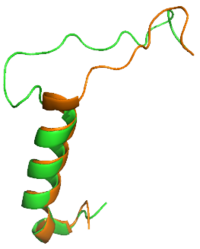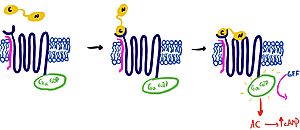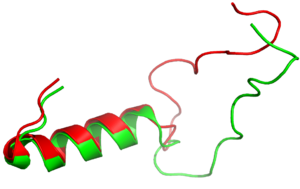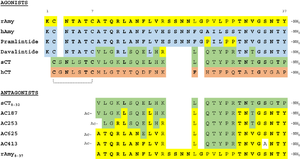Sandbox Ben Whiteside
From Proteopedia
(Difference between revisions)
m (Ben Whiteside moved to Sandbox Ben Whiteside: This should be under the protected user domain or Sandbox since using his name as title. And there is already a page https://proteopedia.org/wiki/index.php/User:Ben_Whiteside) |
|||
| (14 intermediate revisions not shown.) | |||
| Line 13: | Line 13: | ||
The amylin peptide contains a <scene name='10/1038819/N_term_disulfide/3'>covalent disulfide linkage</scene> between residues C2 and C7. This disulfide provides stability and rigidity to the helical structure of the peptide, allowing for favorable binding to the extracellular domain (ECD). Notable interactions formed by this disulfide include hydrogen bonds between E294 of the transmembrane domain with K1 of amylin, and both R362 and W361 of the transmembrane domain forming a hydrogen bond with N3 of amylin. | The amylin peptide contains a <scene name='10/1038819/N_term_disulfide/3'>covalent disulfide linkage</scene> between residues C2 and C7. This disulfide provides stability and rigidity to the helical structure of the peptide, allowing for favorable binding to the extracellular domain (ECD). Notable interactions formed by this disulfide include hydrogen bonds between E294 of the transmembrane domain with K1 of amylin, and both R362 and W361 of the transmembrane domain forming a hydrogen bond with N3 of amylin. | ||
====Amidated C-Terminus==== | ====Amidated C-Terminus==== | ||
| - | The <scene name='10/1038819/Amidated_c_term/9'>C-Terminus</scene> of amylin contains an amide group, rather than a carboxylic acid group. This chemical modification allows for more extensive hydrogen bonding to nearby residues, due to the added hydrogen bond donor on the NH2 group. In turn, this allows for favorable hydrogen bonds between S129 of the transmembrane domain and the main chain of Y37 on amylin. This interaction causes a "kink" in the random coil of amylin, displacing Y37 into a hydrophobic pocket, allowing for favorable hydrophobic interactions with W79 of the transmembrane domain. This amidation is thought to be a post-translational modification. | + | The <scene name='10/1038819/Amidated_c_term/9'>C-Terminus</scene> of amylin contains an amide group, rather than a carboxylic acid group. This chemical modification allows for more extensive hydrogen bonding to nearby residues, due to the added hydrogen bond donor on the NH2 group. In turn, this allows for favorable hydrogen bonds between S129 of the transmembrane domain and the main chain of Y37 on amylin. This interaction causes a "kink" in the random coil of amylin, displacing Y37 into a hydrophobic pocket, allowing for favorable hydrophobic interactions with W79 of the transmembrane domain. This amidation is thought to be a post-translational modification. |
==== Bypass Motif ==== | ==== Bypass Motif ==== | ||
[[Image:SCT_rAmy_Overlay_v2.png|200 px|left|thumb|Figure 1: Overlay of sCT (orange) and rAmy (green)]] | [[Image:SCT_rAmy_Overlay_v2.png|200 px|left|thumb|Figure 1: Overlay of sCT (orange) and rAmy (green)]] | ||
| - | The <scene name='10/1038869/Bypass_overview/3'>Bypass Motif</scene> is a series of residues in the midsection of the amylin peptide that are crucial for providing structural specificity for the AMYR. Without RAMP association, the CTR is in a relaxed, fluid state, allowing the binding of <scene name='10/1038869/Sct_bypass/1'>Calcitonin</scene>. When RAMP binds the receptor, it is forced into a new, rigid conformation, which interferes with calcitonin binding. Amylin's bypass motif contains a backbone configuration that does not interfere with AMYR, allowing the C-terminus of the peptide to interact with the extracellular domain. The Bypass Motif also binds <scene name='10/1038869/Bypass-ecdl_h-bond/4'>extracellular domain loop 4</scene> and makes <scene name='10/1038869/Bypass-amyr/3'>hydrophobic interactions</scene> with the transmembrane region of AMYR, anchoring the peptide in place for the signaling process to occur | + | The <scene name='10/1038869/Bypass_overview/3'>Bypass Motif</scene> is a series of residues in the midsection of the amylin peptide that are crucial for providing structural specificity for the AMYR. Without RAMP association, the CTR is in a relaxed, fluid state, allowing the binding of <scene name='10/1038869/Sct_bypass/1'>Calcitonin</scene>. When RAMP binds the receptor, it is forced into a new, rigid conformation, which interferes with calcitonin binding. Amylin's bypass motif contains a backbone configuration that does not interfere with AMYR, allowing the C-terminus of the peptide to interact with the extracellular domain. The Bypass Motif also binds <scene name='10/1038869/Bypass-ecdl_h-bond/4'>extracellular domain loop 4</scene> and makes <scene name='10/1038869/Bypass-amyr/3'>hydrophobic interactions</scene> with the transmembrane region of AMYR, anchoring the peptide in place for the signaling process to occur<ref name="Cao">PMID:35324283</ref>. |
==Amylin Receptor Binding== | ==Amylin Receptor Binding== | ||
| Line 24: | Line 24: | ||
<scene name='10/1038828/Ramp_ctr_interface/9'>RAMP CTR Interface </scene> is a key interaction that stabilizes the protein complex and positions the receptor to favorably bind to amylin. The RAMP-CTR interface extends into the plasma membrane, providing additional non-covalent bonding between the protein complex and the cell membrane. | <scene name='10/1038828/Ramp_ctr_interface/9'>RAMP CTR Interface </scene> is a key interaction that stabilizes the protein complex and positions the receptor to favorably bind to amylin. The RAMP-CTR interface extends into the plasma membrane, providing additional non-covalent bonding between the protein complex and the cell membrane. | ||
==== Extracellular Domain - RAMP interactions ==== | ==== Extracellular Domain - RAMP interactions ==== | ||
| - | The extracellular domain of the CTR primarily contains polar residues in the extracellular space. In order to orient these residues to facilitate amylin binding, <scene name='10/1038828/Ctr_ramp_ecd_stablization/7'>RAMP | + | The extracellular domain of the CTR primarily contains polar residues in the extracellular space. In order to orient these residues in such a way to facilitate amylin binding, RAMP makes hydrogen bonds with the CTR to increase the rigidity of the receptor binding site. <scene name='10/1038828/Ctr_ramp_ecd_stablization/7'>RAMP CTR Extracellular Domain Interaction</scene> |
== Clinical Significance == | == Clinical Significance == | ||
Current revision
AMYR
| |||||||||||
Student Contributors
Andrew Helmerich, Mathias Vander Eide, Ben Whiteside




